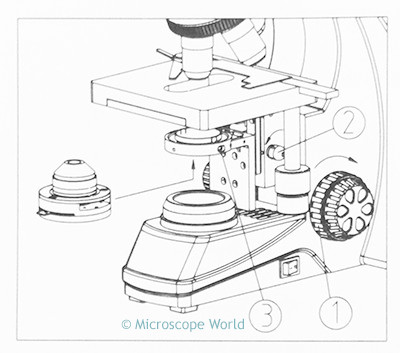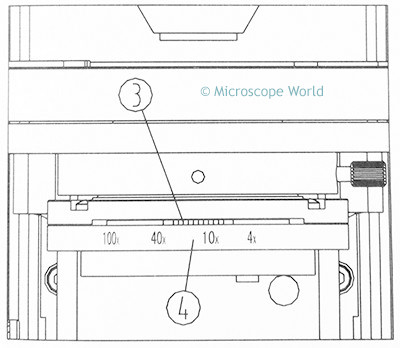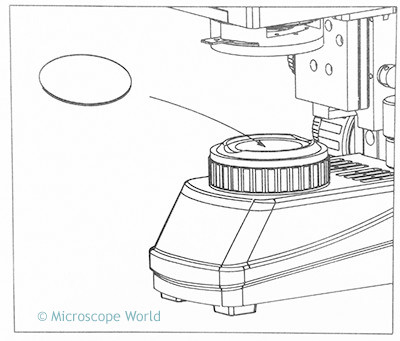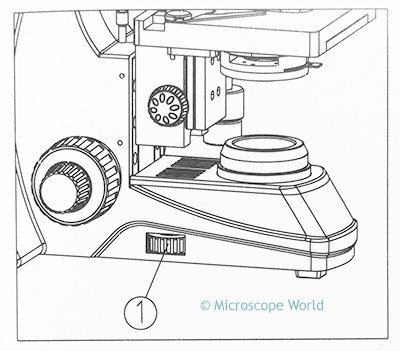The microscope condenser is an important part of a compound light microscope as it helps focus the light through the sample and the objective lens. When looking through the microscope if you are having trouble with the light of your microscopy sample, or perhaps the image looks dark, chances are you may need to make an adjustment with your microscope condenser.
Microscope Condenser Installation
 When installing the microscope condenser, rotate the coarse focus knob (1) to move the stage to its highest position. Most compound light microscopes have a small knob (2) to raise and lower the condenser holder. Lower this holder so the condenser can slide into the holder below the stage. Once you have inserted the condenser, tighten the set screw (3) to hold the condenser in place. Finally, raise the condenser back up to its highest position (using knob 2 in the image shown at left) so the light is just beneath the microscope slide.
When installing the microscope condenser, rotate the coarse focus knob (1) to move the stage to its highest position. Most compound light microscopes have a small knob (2) to raise and lower the condenser holder. Lower this holder so the condenser can slide into the holder below the stage. Once you have inserted the condenser, tighten the set screw (3) to hold the condenser in place. Finally, raise the condenser back up to its highest position (using knob 2 in the image shown at left) so the light is just beneath the microscope slide.
Most condensers will also have two screws on either side of the condenser holder. These are condenser centering screws. While looking through the microscope with the iris part way open, adjust each screw so the cone of light is centered in the microscope field of view.
Adjusting the Iris Diaphragm on the Microscope Condenser
 The image at right shows a microscope condenser from the front of the microscope. The condenser has a lever (3) on the front of it that can be moved to the far right or left. This lever adjusts the iris diaphragm. Some condensers will have corresponding objective values printed on the condenser (4), while others will not. When using the 4x microscope objective lens, the iris diaphragm lever should be pushed all the way to the right. When this lever is moved to the right, less light is sent through the condenser, resulting in an image that is not too bright. When using the 100x objective, move the lever all the way to the left to open the iris diaphragm and allow more light to pass through the condenser, resulting in a better image.
The image at right shows a microscope condenser from the front of the microscope. The condenser has a lever (3) on the front of it that can be moved to the far right or left. This lever adjusts the iris diaphragm. Some condensers will have corresponding objective values printed on the condenser (4), while others will not. When using the 4x microscope objective lens, the iris diaphragm lever should be pushed all the way to the right. When this lever is moved to the right, less light is sent through the condenser, resulting in an image that is not too bright. When using the 100x objective, move the lever all the way to the left to open the iris diaphragm and allow more light to pass through the condenser, resulting in a better image.
Adjusting the Field Iris for Koehler Illumination
 Biological microscopes with Koehler illumination will have a field iris. In the image shown at left, the field iris is adjusted by rotating the light housing (the part below where the arrow is pointing). Koehler illumination is a method of specimen illumination that evenly spreads the light across the sample and ensures that an image of the light source is not visible in the resulting microscopy image. Koehler illumination is found in more advanced biological microscopes and is typically not found in basic high school microscopes. In order to obtain Koehler illumination the microscope must have a collector lens and/or field lens, a field iris diaphragm, a condenser iris diaphragm and a condenser lens. When looking through the microscope the field iris should be adjusted when the magnification of the microscope is changed to ensure an evenly lit sample.
Biological microscopes with Koehler illumination will have a field iris. In the image shown at left, the field iris is adjusted by rotating the light housing (the part below where the arrow is pointing). Koehler illumination is a method of specimen illumination that evenly spreads the light across the sample and ensures that an image of the light source is not visible in the resulting microscopy image. Koehler illumination is found in more advanced biological microscopes and is typically not found in basic high school microscopes. In order to obtain Koehler illumination the microscope must have a collector lens and/or field lens, a field iris diaphragm, a condenser iris diaphragm and a condenser lens. When looking through the microscope the field iris should be adjusted when the magnification of the microscope is changed to ensure an evenly lit sample.
Using Filters
The image above shows where microscope filters are typically placed (above the light source) on a compound light microscope. Filters are used both for observation and photo microscopy. Learn more about microscope filters and their uses here.
Adjusting Light Intensity
 A microscope condenser will operate optimally when the light intensity of the microscope is also set accordingly. A good rule of thumb to remember is that lower magnifications require less light. Additionally, depending on the type of light you are using (LED is a much brighter light than fluorescent), you may need to adjust the light intensity control (1) on your microscope.
A microscope condenser will operate optimally when the light intensity of the microscope is also set accordingly. A good rule of thumb to remember is that lower magnifications require less light. Additionally, depending on the type of light you are using (LED is a much brighter light than fluorescent), you may need to adjust the light intensity control (1) on your microscope.




